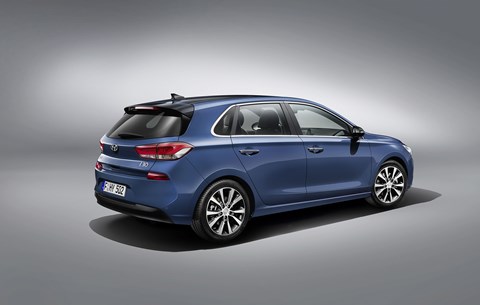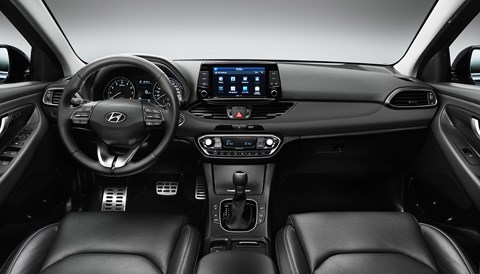► Hyundai’s new i30 hatchback unveiled
► Dubbed the DNA car for the South Korean brand
► Available in early 2017 for around £15,500
Hyundai describes its latest generation of i30 hatchback as the ‘DNA car’ for the company, with its arrival designed to spearhead the brand’s latest assault on the European market.
Clearly sick of playing second fiddle to the Volkswagen Golfs and Ford Focuses of the automotive world, the South Korean manufacturer has gone all out to win over the discerning European hatchback buyer – with a very Euro-flavoured hatchback clone.
Designed, developed, tested and manufactured in Europe, one could even be forgiven for thinking that this latest Hyundai has serious designs on the UK’s soon-to-be-vacant Eurozone seat.
The new i30 looks familiar…
Yes, it appears that Hyundai, in its quest for European acceptancy, has drawn inspiration from a whole host of established rival models. The rear end, for example, has – despite the oddly-placed crease beneath the rear brake lights – more than a hint of VW Golf and BMW 1-series about it, while the side-profile looks to have taken design cues from the Alfa Romeo Giulietta and Peugeot 308.

We’re not yet sold on the look, with the front end appearing a little too gaping and the rear being overly complicated – but keep an eye out for further impressions after we’ve had a proper look at the car.
Hasn’t this been tested at the Nurburgring?
Indeed it has, Hyundai pressing this European theme home further with its choice of test venue. Since opening its Nurburgring research and development centre, the brand claims to have done over 20,000 laps of the Green Hell in an effort to hone the handling and driving dynamics of its cars.

Some may find this hard to believe but this latest i30 has the hardware to back up its bold claims. Multi-link rear suspension and a quicker steering rack are standard on all models, as are what Hyundai refers to as ‘performance-oriented shock absorbers.’
Has it got the engines to match its chassis?
Well, there’s plenty of choice – three petrol engines and three diesels, to be precise. Highlights of the unleaded fuel choice include a 118bhp 1.0-litre turbocharged three-cylinder motor, and the range-topping 138bhp 1.4-litre turbocharged four-cylinder engine – good for 0-62mph in a claimed 8.9 seconds.
If you want a diesel, you’ve the option of a 1.6-litre turbo diesel in three different power outputs. The lowest makes 94bhp and produces as little as 94g/km of CO2, while the highest produces a punchy 134bhp and 221 ft lb, accelerating the 1.2-tonne i30 from 0-62mph in 10.6 seconds.

Customers will have a choice between the standard six-speed manual transmission and a dual-clutch seven-speed automatic ‘box.
Any clever bits of tech on offer?
Customers can choose between the standard-issue five-inch floating touchscreen (complete with Bluetooth and an integrated rear-view camera) or the more premium eight-inch equivalent, boasting TomTom sat-nav software and Apple CarPlay/Android Auto. Wireless phone charging will also be fitted as standard with the pricier infotainment system.
Other gadgets offered on the i30 include autonomous emergency braking, driver attention alert, adaptive cruise control, blindspot detector, lane-keep assist, rear-cross traffic alert, traffic-sign recognition and high-beam assist.

CAR understands that Hyundai will soon fit digital instruments to its models, including the i30 – apeing Audi’s Virtual Cockpit.
Safety-wise, Hyundai points towards the i30’s seven airbags and 22% increase in rigidity over the previous model.
Anything else I should know?
Hyundai has stated that the i30 hatch will spawn a range of additional models, including a high-performance ‘N’ version – the first from the company’s newly-formed performance brand. Pricing has yet to be confirmed for the i30, which goes on sale in early 2017, but expect the base petrol model to start from around £15,500.
Read more Paris motor show news here